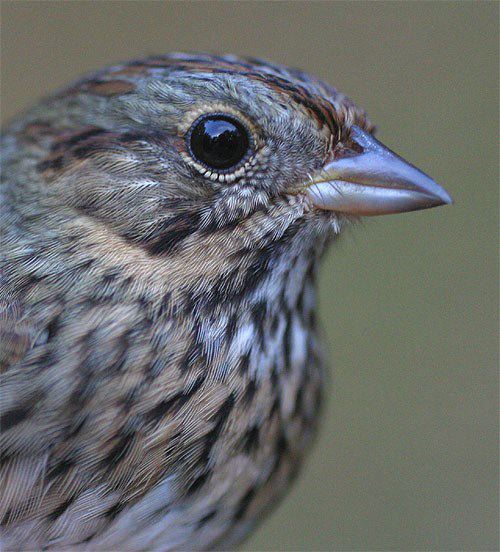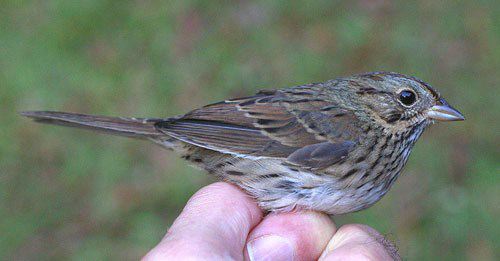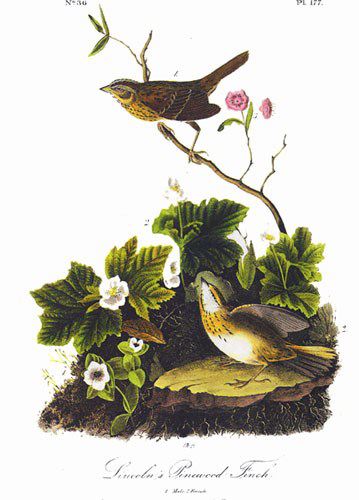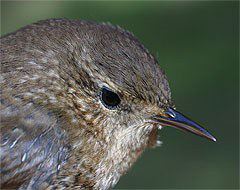|
|
|||
|
THIS WEEK at HILTON POND |
|
THOMAS LINCOLN'S LBJ If your field guide is set up in traditional fashion, the last 20 pages or so are devoted to sparrows. Beginning birdwatchers often feel overwhelmed by illustrations in that final section, believing that all sparrows look alike and that identifying individual species is hopeless. Even experienced birders sometimes shrug their shoulders after getting a quick glimpse of a sparrow in the thicket and simply record it as an "LBJ"--a "Little Brown Jobber." Like most places in the Piedmont, we've got some LBJs here at Hilton Pond Center, but we try not to let their similarities get the best of our attempts at identification.  Not all sparrows are LBJs, of course. Some species in the Carolina Piedmont are quite distinctive and easily identified, especially in full breeding plumage. For example, a bright, freshly molted White-throated Sparrow quickly reveals the origin of its name, and the combination of white eyeline, gray rump, and rusty-red cap is a dead give-away for a springtime Chipping Sparrow. Other Piedmont sparrows present more difficult challenges, especially when they flush from an old field and plunge just as quickly into dense stands of Goldenrod and Broomsedge. If there's a flash of white from the outer tail feathers of an otherwise brown bird, you can call it a Vesper Sparrow, or if it's a hefty bird with dark breast streaking and rusty rump and tail then Fox Sparrow is the certain ID. Some sparrows, however, are so uncooperative in behavior or generic in appearance that without a good long look it's often hard to know just what you've got. That's when running mist nets is an advantage: it's a lot easier to identify a sparrow in the hand than in the bush--especially when it's an uncommon species. Such was the case this week at Hilton Pond Center, when we netted one of the most elusive Piedmont sparrows. The bird--caught in the bottom net shelf--was almost on the ground and from a distance appeared to be another of the Song Sparrows that started showing up locally in mid-October. As soon as we reached for the bird, however, we saw that instead of a Song Sparrow's dark streaking and central breast spot the bird bore distinct, thin, vertical streaks and a wide, buffy horizontal band. Lincoln's Sparrow!  Now here's a species we were excited to catch for several reasons. For one, it was only the sixth Lincoln's Sparrow out of nearly 42,000 birds banded since 1982 at the Center. For another, some bird enthusiasts go years or even lifetimes without making positive identification of a Lincoln's Sparrow in the field. The problem is that Lincoln's Sparrows are skulkers that come down from their northern breeding grounds and seem to spend winter days trying to elude the gaze of Carolinas birders. Roger Tory Peterson said Lincoln's Sparrows are afraid of their own shadows, an indication that they take flight at the first sign of danger and disappear into the underbrush when other kinds of sparrows simply perk up and look around. Even John James Audubon had trouble spying this bird; it wasn't until Thomas Lincoln was able to bag one on a collecting trip to Labrador in 1832 that Audubon got a good look at the species and, out of gratitude, named the sparrow for the young sharpshooter--but not after some future U.S. president as is commonly believed. (See Audubon's impressions of "Lincoln's Pinewood Finch" in his painting below right.)
On the breeding grounds--primarily in muskegs and willow-alder thickets of Canada, Alaska, and the very northern edge of the contiguous U.S.--the male sings a fairly complex and sweet song. Meanwhile, the female quietly sits on her clutch of eggs in a grassy nest she builds on the ground. After raising their annual brood, some Lincoln's Sparrows come to spend the winter in the Piedmont and Coastal Plain of the Carolinas, but other individuals head as far south as Guatemala. This makes them Neotropical migrants--a term we associate more often with warblers and tanagers than with sparrows--and a species whose future breeding success depends in part on habitat protection south of the Rio Grande. If you're off to Mexico on holiday this winter, you might keep an eye out for Thomas Lincoln's LBJ. Even if Lincoln's Sparrows are there, however, we doubt it will be any easier to see and identify one in the field in Central America than it is at Hilton Pond Center. If you enjoy "This Week at Hilton Pond," please help Support Hilton Pond Center for Piedmont Natural History. It's painless, and YOU can make a difference! You may wish to consult our Index of all nature topics covered since February 2000. |

 Lincoln's Sparrows, Melospiza lincolnii, are 5.5" long-- about the same size as the closely related Song Sparrow, M. melodia. Lincoln's Sparrow, however, has a gray face, narrow eye ring, and trimmer build--plus the other characters mentioned above and illustrated in the photos on this page. As with most LBJs, sexes look alike in the Lincoln's Sparrow.
Lincoln's Sparrows, Melospiza lincolnii, are 5.5" long-- about the same size as the closely related Song Sparrow, M. melodia. Lincoln's Sparrow, however, has a gray face, narrow eye ring, and trimmer build--plus the other characters mentioned above and illustrated in the photos on this page. As with most LBJs, sexes look alike in the Lincoln's Sparrow.

